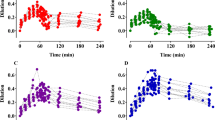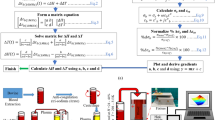Abstract
To evaluate the role of plasma chemistry in the genesis of electrical impedance of blood, a laboratory simulation was performed using solutions prepared so as to mimic plasma chemistry abnormalities that are seen in the critically ill. There was a 15% increase of impedance due to decrease in sodium chloride concentration from 140 mmol/L to 120 mmol/L, and a 12% decrease of impedance due to increase in sodium chloride to 160 mmol/L. Impedance changes secondary to other chemistry abnormalities were small and probably not significant, with the exception of a change of albumin concentration from 80 gm/L to 50 gm/L, which induced a 6% increase in impedance. Using this data, a model was constructed to predict changes in whole blood resistivity, and this was extrapolated in two simulations of plasma chemistry abnormalities to predict alterations of calculated impedance stroke volume in excess of 5%.
Similar content being viewed by others
References
Fricke, H.; Morse, S. The electrical resistance and capacity of blood for frequences between 800 and 4 1/2 million cycles. J. Gen. Physiol. 9:153–167; 1926.
Geddes, L.A.; Baker, L.E. The specific resistance of biological material: A compendium of data for the biomedical engineer and physiologist. Med. Biol. Engin. 5:271–293; 1967.
Geddes, L.A.; Sadler, C. The specific resistance of blood at body temperature. Med. Biol. Engin.: IEEE Trans 20:336–339(51–53); 1973.
Hill, D.W.; Thompson, F.D. The effect of haematocrit on the resistivity of human blood at 37 degrees Celsius and 100 kHz. Med. Biol. Engin. March: 182–186; 1975.
Kubicek, W.G.; Kottke, F.J.; Ramos, M.U.; Patterson, R.P.; Msee, D.A.; Labree, J.W.; Remole, W.; Layman, T.E.; Schoening, H.; Garamela, J.T. The Minnesota impedance cardiograph—theory and applications. Biomed. Eng. 9:410–416, 1974.
Mohapatra, S.N.; Costeloe, K.L.; Hill, D.W. Blood resistivity and its implications for the calculation of cardiac output by the thoracic electrical impedance technique. Intensive Care Med. 3:63–67; 1977.
Sigman, E.; Kolin, A.; Katz, L.; Jochim, K. Effect of motion on electrical conductivity of the blood. Am. J. Physiol. 118:708–719; 1937.
Visser, K.R.; Lamberts, R.; Zijlstra, W.G. Investigation of the parallel conductor model of impedance cardiography by means of exchange transfusion with stroma free haemoglobin solution in the dog. Cardiovasc. Res. 21:637–645; 1987.
Rosenthal, R.L.; Tobias, C.W. Measurement of electrical resistance of human blood: Use in coagulation studies and cell volume determination. J. Lab. Clin. Med. 33:1110–1122; 1948.
Author information
Authors and Affiliations
Rights and permissions
About this article
Cite this article
Fuller, H.D. The electrical impedance of plasma: A laboratory simulation of the effect of changes in chemistry. Ann Biomed Eng 19, 123–129 (1991). https://doi.org/10.1007/BF02368464
Received:
Revised:
Issue Date:
DOI: https://doi.org/10.1007/BF02368464




